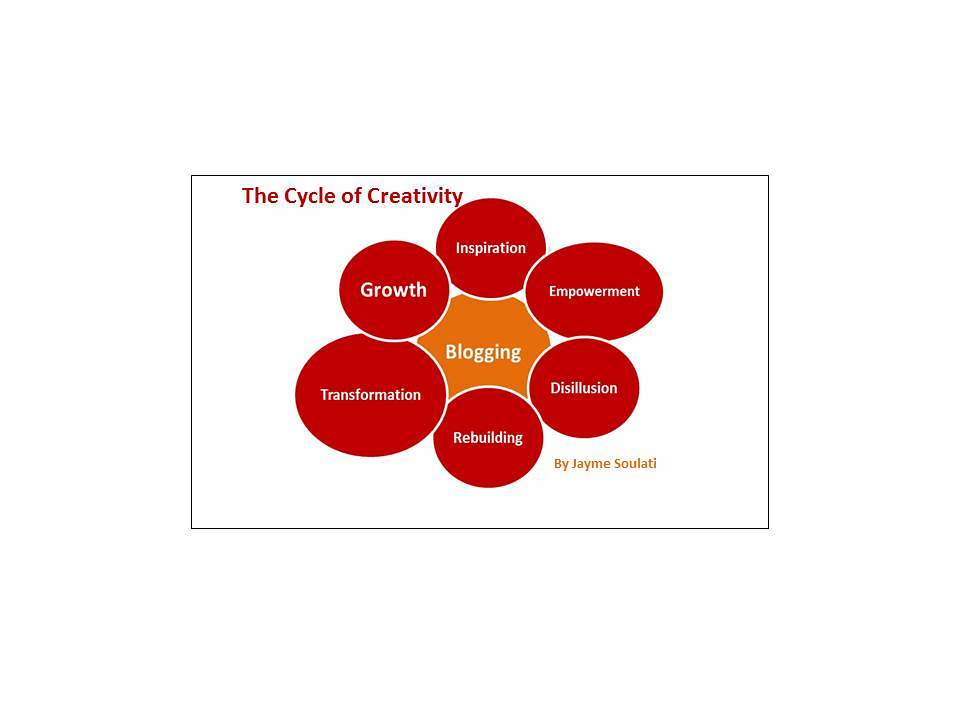 When you think of how you create anything, there is a cyclical nature to the entire process. Creativity has been studied for years by the academicians and scientists attempting to master innovation, the world’s most creative companies, the people with the brightest idea, and all the other elements that go into being creative.
When you think of how you create anything, there is a cyclical nature to the entire process. Creativity has been studied for years by the academicians and scientists attempting to master innovation, the world’s most creative companies, the people with the brightest idea, and all the other elements that go into being creative.
Think of Yourself
Are you a content marketer? Does that mean you’re a blogger? How do you assess your creativity if you wear these titles? I’m going to hasten a guess that the ebbs and flows of blogging and content creation provide great rewards and serious depression, right?
I know this because my 3.9 years of blogging for my own professional blog and the additional 12 to 18 months as a guest blogger for many other blogs makes me somewhat of a poster child for this graphic I created about creativity.
Here’s a secret – I had the word “blogging” in the middle circle instead of creativity. I thought about putting content marketing in the center; however, I truly wanted this graphic to be your thought starter for whatever you’re creating…maybe you’re on the road to building a new life with a partner; perhaps you’re launching a career; how about finding your spirituality or coming to terms with who you are as a person? Or, you can be just a blogger, like me, for the purposes of this story.
Thinking About Creativity
A few clarifiers first:
- Perhaps the elements can be labeled something else; these are my experiences to plant a seed for yours.
- I didn’t study creativity to get to these; I made this all up, but its real from the now experience.
- There’s a significant thought about the cycle of creativity and that’s timing. There is no set number of days or months you can rotate through these stages. Let’s hope you’ll spend more time on the positive side of growth, inspiration and empowerment; however, if you spend too much time, then you’re not rebuilding and transforming, right?
- At any time within this cycle, you should never experience any one thing 100 percent. That would be entirely dangerous! Let’s think about that…if you were 100 percent disillusioned, you’d likely shut down your blog and never blog again. If you were growing 100 percent without an eye on being inspired to develop the next big idea, you would fail at creativity. I suggest and 80/20 Pareto Principle on this; spend 20 percent of the creative cycle asking the tough questions, challenging the status quo, and preparing to be inspired to rebuild as you’re knee deep in 80 percent of the stage you’re experiencing.
- Lastly, if you are unable to recognize these stages in yourself (as a content marketer or blogger), then give it more time. If you’ve not been blogging two to three years straight with an average of four posts weekly, you may not have notched enough time on your belt to have experienced these elements.
Six Stages in The Cycle of Creativity
- Inspiration. One can never be creative without the inspiration to be such. There has to be a button that gets pushed to turn on the inspiration, right? NO, actually not! Creativity is finest when someone is inspired and excited about something or someone. Passion is ignited or flamed when you listen differently or watch behaviors intently. Your inspiration comes from your spirit and how you carpe diem. I get inspiration for everything I write from current events, conversations, observations, and my own robust experiences.
- Empowerment. When you’re inspired and all cylinders click, there comes a feeling of empowerment that is so rewarding and enlightening. The energy is fueled by a continuous injection of inspiration and light-bulb moments that are so evident in writing and creativity. It’s nearly euphoric, and the flow of production is heightened.
- Disillusion. The pace of empowerment can last as long as your energy to create at a highly productive level. My latest stage of empowerment was six months, and then I crashed. The questions began to overtake the creativity and inspiration, and the disillusionment hit hard with the biggest question – “why am I doing this?” I encourage everyone to embrace this stage positively; if you only have a negative reaction to being disillusioned as a writer, then you will infect your writing! People read you for the positive spirit you bring. When I feel the lowest, I focus outward and find someone to profile on my blog. Giving gifts that are not monetary is such a lovely way to move out of the disillusion phase.
- Transformation. Once you begin to ask why, instead of complaining about your malcontent, you can begin to transform. This phase includes the “what’s next” and “how do I get there” stage. It’s so highly critical and challenging because it involves a hearty introspective look at your outside self. When you hit the blog daily to find something to write about, it becomes second nature; however, when you stop caring what you’re writing about, you become disillusioned and need to transform. Spend time here because without the health transformation, you will not enter the next phase.
- Rebuilding. Perhaps transformation and rebuilding are too similar to understand. I think this stage is oriented to take action. Let’s say I realized in my introspective state (transformation) that I no longer liked what my “house” looked like, then in the rebuilding stage, I would hire a developer/designer to spiff up my website and blog. I would also speak to the experts about things I didn’t know and hadn’t incorporated so I could seriously rebuild my foundation. This stage of creativity is probably the single-most critical element in the entire cycle. If you can’t rebuild your cracked foundation or repair the hole in the wall, you cannot thrive.
- Growth. The hard work is nearly done; your house is in order, you are breathing deeply with satisfaction about the changes you made, and you’re ready to grow. Not that easy! Neither of these stages have an exact stop/start; in fact, they overlap quite a bit. As you transform and rebuild together, you also begin the growth phase during rebuilding as your inspiration picks up to empower you. One thing is for sure, your creativity can grow as a writer or in life at any of these stages; it just may be thwarted a bit at about 20 percent versus 90 percent. That’s a really great observation to point out, too.
Can you use this for a life experience that may not be about blogging or content marketing? Switch out the center theme and insert one of your own…see if the stages still fit the wheel.
This Post Originally Appeared on Steamfeed.com by Jayme Soulati.













